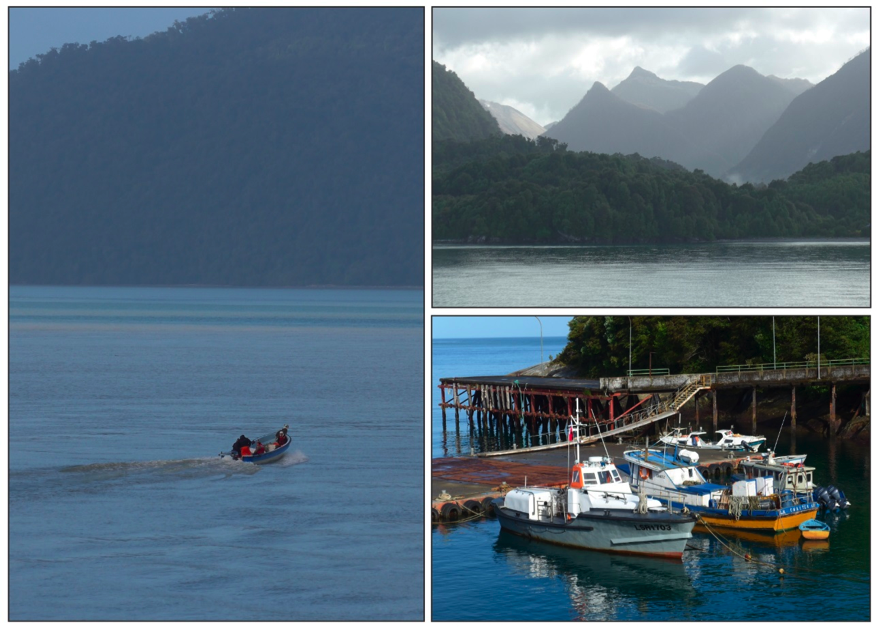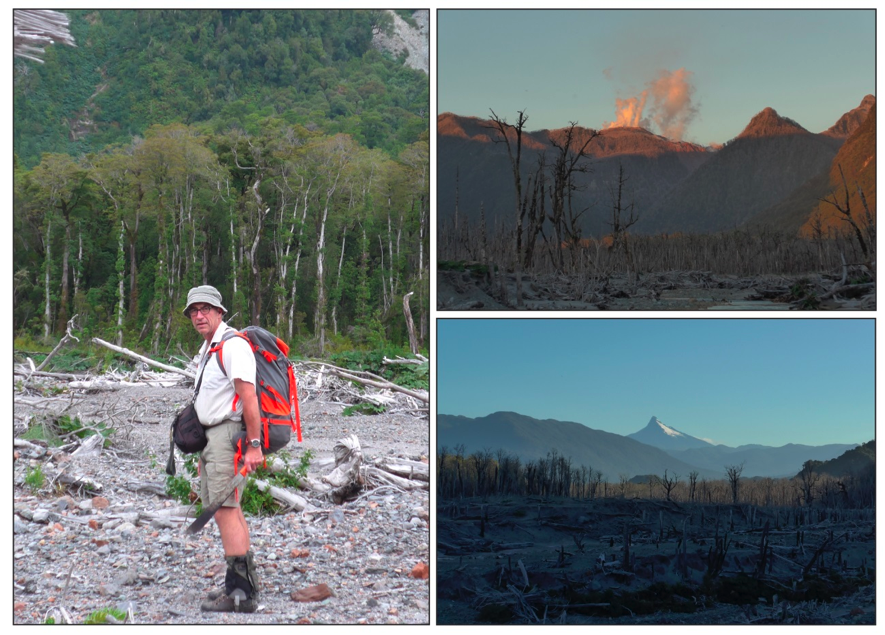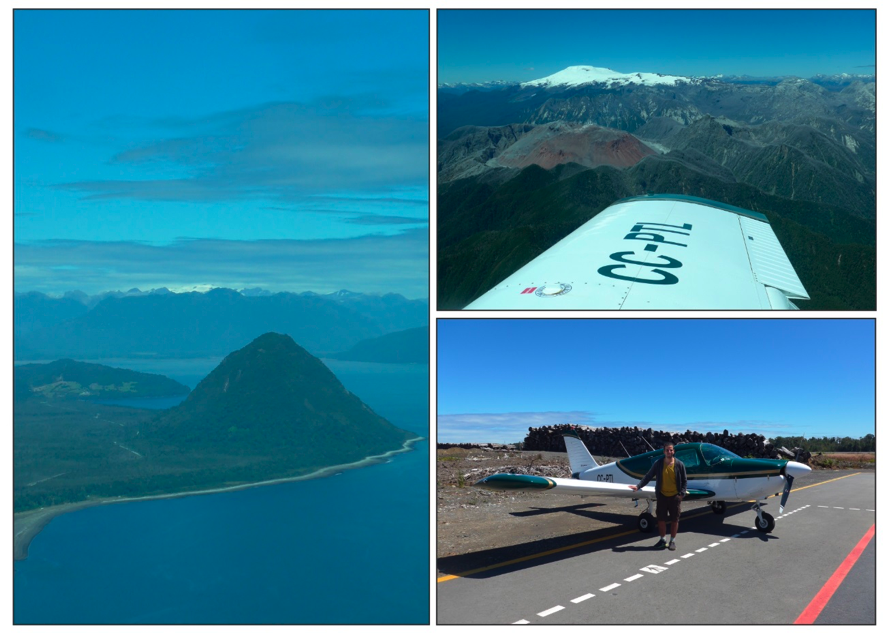By Ignacio Jara
26 January
It is somewhat symbolic that the initial stop of my field season in Chile is the very same place where, one year ago, Brent Alloway and I finished Victoria University, Wellington, School of Geography, Earth and Environmental Sciences first international field trip with a traditional Patagonian asado (spit barbeque)… but this summer the mission is different.
Last night Brent showed me satellite images depicting what looks like an unrecognized volcanic dome right next to Chaitén volcano. Based on the geochemical analysis of ash layers found in road cuts around Chaitén, Brent is convinced that this previously unrecognized dome has erupted at least once in the last millennium. The plan is try to get to the dome, have a look and take some rock samples to analyze and compare. Looking at the maps, we agreed that it will be a difficult objective since the area is covered by dense temperate rain-forest without any visible tracks. But we are optimistic.
27 January
For now, my field trip has been about planning and enjoying the hospitality of Brent which includes good food and of course the marvelous Chilean Carménère wines. However, tonight this enjoy-without-working scenario will change when we meet a fieldwork team from Universidad de Chile to embark on the Don Baldo ferry for an overnight trip that will take us down south to the Chaitén province, the northern gate of Patagonia.

28 January
Our arrival to Chaitén early this morning couldn’t have been more beautiful (photo 1). From the Ferry’s deck the greenness of the forest, the calm of the waters and the mountains on the background reminded me the Marlborough Sounds after crossing the Cook Strait. While the ferry slowly made its final way trough a narrow channel before arriving at the small landing platform, greeted by a couple of tourists waiting on the shore to take the same ferry back to mainland Chile. A calm tranquil morning in the small town of Chaitén.
29 January
With Brent and two other students we spent the whole day trekking up the Chaitén valley trying to reach the newly discovered lava dome. The devastation in Chaiten township and up the valley produced by the ashes and pyroclastic flow during the 2008 eruption is simply overwhelming. Tramping around burned trunks, strong smelling sulfide orange-coloured streams and being completely surrounded by tons of white ashes evokes a special feel of devastation and remind us that nature is both powerful and deadly (Photo 2).
At the end of the day we were unable to reach the dome. It was just too difficult to get to. We traversed the river valley as much as we could but we were impeded by a massive waterfall which prevented us from progressing further. Obviously we are bit disappointed and frustrated but trying to get around the waterfall through the impenetrable forest and vertical terrain would undoubtedly have been too risky.

31 January
Despite our failure in trying to reach the volcano, Brent still wants to have a closer look. He has contacted a local pilot to fly a small 1969 Piper Cherokee monoplane over the crater. A bit scary considering the size of the airplane was not bigger than Mini Cooper with wings (Photo 3)!
Luckily, we enjoyed a stunning sunny day without any of those gusty winds that I usually experience in Wellington. Only one of those winds would have made the monoplane shake like a scared dog (Photo 3)!
Leaving all those concerns aside, the views were simply fantastic! The mountains, the endless coastline and the Chaitén volcano with all of its ash from the 2008 eruption mantling the surrounding area, created a wonderful visual experience. But more importantly, the views from the aircraft confirm that there is now a new satellite dome just a stone throw from Chaitén Volcano.

2 February
After our flying adventure we have now rejoined the group from Universidad de Chile in Futaleufú, a small town 80 kilometer inland from Chaitén. Over the next few days we will be on a raft coring two small lakes in the surroundings. Despite their small size, the access to the lakes is always a main issue and that wasn’t an exception during this fieldtrip. It turned out that one of the lakes was actually on the top of a small hill and there wasn’t any nearby road allowing for vehicles to get the coring platform to the lake edge. We therefore needed the assistance of a bow yoke with two old oxen to bring all our equipment up to a steep farm track. …..the Patagonian way (photo 4)!

5 February
After 3 days of pretty intense coring work are we now finished with our first lake and moving on to another lake, just on the outskirts of Futaleufú town (Photo 4). Very hot, dry, sunny days working on the raft and as a result I got a little sunburnt. I am tired and I miss all the comforts of the city, but I am also very excited with our progress as we retrieved a lot of core containing sediments that will be the final part of my PhD thesis. There is an impressive variety of layers preserved in the lake sediments, including countless volcanic ash layers (to keep Brent happy!), wood fragments, glacial silts and nasty black charcoal layers inter-fingered. So much work to do reconstruction the history of the lake!
8 February
Another three days working in our second lake and now we have even more sediment to analyse (I am not that sure how lucky I am now!) Our field trip is coming to an end. Tomorrow we will drive back to Chaitén and then board the overnight ferry that will take us back to mainland Chile. In Santiago, I will spend the next two months sampling and processing the sediment we got in the field.
For me this has been a great time to reconnect with the people I worked with during my Masters. Hard work? For sure. Rewarding? Absolutely! Now I must get to work in the lab – lots of samples to process, pollen to count and a PhD to finish!
Ignacio wants to thanks Dr. Patricio Moreno and all the members of Laboratorio de Palinologia Quaternaria at Universidad de Chile for all their support during the field and laboratory work described in the column above.